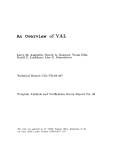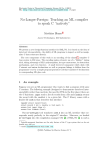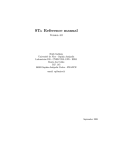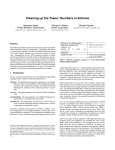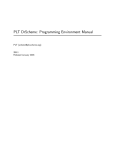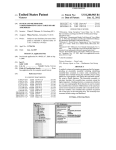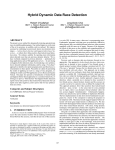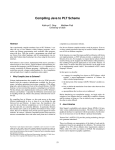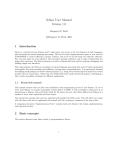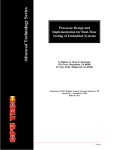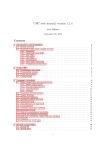Download Contracts for Higher-Order Functions
Transcript
Contracts for Higher-Order Functions
Robert Bruce Findler1
Matthias Felleisen
Northeastern University
College of Computer Science
Boston, Massachusetts 02115, USA
Abstract
1
Assertions play an important role in the construction of robust software. Their use in programming languages dates back to the 1970s.
Eiffel, an object-oriented programming language, wholeheartedly
adopted assertions and developed the “Design by Contract” philosophy. Indeed, the entire object-oriented community recognizes the
value of assertion-based contracts on methods.
Dynamically enforced pre- and post-condition contracts have been
widely used in procedural and object-oriented languages [11, 14,
17, 20, 21, 22, 25, 31]. As Rosenblum [27] has shown, for example,
these contracts have great practical value in improving the robustness of systems in procedural languages. Eiffel [22] even developed
an entire philosophy of system design based on contracts (“Design
by Contract”). Although Java [12] does not support contracts, it is
one of the most requested extensions.1
In contrast, languages with higher-order functions do not support
assertion-based contracts. Because predicates on functions are,
in general, undecidable, specifying such predicates appears to be
meaningless. Instead, the functional languages community developed type systems that statically approximate interesting predicates.
In this paper, we show how to support higher-order function contracts in a theoretically well-founded and practically viable manner. Specifically, we introduce λC ON , a typed lambda calculus with
assertions for higher-order functions. The calculus models the assertion monitoring system that we employ in DrScheme. We establish basic properties of the model (type soundness, etc.) and
illustrate the usefulness of contract checking with examples from
DrScheme’s code base.
We believe that the development of an assertion system for higherorder functions serves two purposes. On one hand, the system has
strong practical potential because existing type systems simply cannot express many assertions that programmers would like to state.
On the other hand, an inspection of a large base of invariants may
provide inspiration for the direction of practical future type system
research.
Categories & Subject Descriptors: D.3.3, D.2.1; General Terms: Design, Languages, Reliability; Keywords: Contracts, Higher-order Functions, Behavioral Specifications, Predicate Typing, Software Reliability
1 Work partly conducted at Rice University, Houston TX. Address as of
9/2002: University of Chicago; 1100 E 58th Street; Chicago, IL 60637
Permission to make digital or hard copies of all or part of this work for personal or
classroom use is granted without fee provided that copies are not made or distributed
for profit or commercial advantage and that copies bear this notice and the full citation
on the first page. To copy otherwise, to republish, to post on servers or to redistribute
to lists, requires prior specific permission and/or a fee.
ICFP’02, October 4-6, 2002, Pittsburgh, Pennsylvania, USA.
Copyright 2002 ACM 1-58113-487-8/02/0010 ...$5.00
Introduction
With one exception, higher-order languages have mostly ignored
assertion-style contracts. The exception is Bigloo Scheme [28],
where programmers can write down first-order, type-like constraints on procedures. These constraints are used to generate more
efficient code when the compiler can prove they are correct and are
turned into runtime checks when the compiler cannot prove them
correct.
First-order procedural contracts have a simple interpretation. Consider this contract, written in an ML-like syntax:
f : int[> 9] → int[0,99]
val rec f = λ x. · · ·
It states that the argument to f must be an int greater than 9 and
that f produces an int between 0 and 99. To enforce this contract, a
contract compiler inserts code to check that x is in the proper range
when f is called and that f ’s result is in the proper range when f
returns. If x is not in the proper range, f ’s caller is blamed for
a contractual violation. Symmetrically, if f ’s result is not in the
proper range, the blame falls on f itself. In this world, detecting
contractual violations and assigning blame merely means checking
appropriate predicates at well-defined points in the program’s evaluation.
This simple mechanism for checking contracts does not generalize
to languages with higher-order functions. Consider this contract:
g : (int[> 9] → int[0,99]) → int[0,99]
val rec g = λ proc. · · ·
The contract’s domain states that g accepts int → int functions and
must apply them to ints larger than 9. In turn, these functions must
produce ints between 0 and 99. The contract’s range obliges g to
produce ints between 0 and 99.
1 http://developer.java.sun.com/developer/bugParade/top25rfes.html
Although g may be given f , whose contract matches g’s domain
contract, g should also accept functions with stricter contracts:
h : int[> 9] → int[50,99]
val rec h = λ x. · · ·
g(h ),
functions without explicit contracts:
g(λ x. 50),
functions that process external data:
read num : int[> 9] → int[0,99]
val rec read num = λ n. · · · read the nth entry from a file · · ·
g(read num),
2
Example Contracts
We begin our presentation with a series of Scheme examples that
explain how contracts are written, why they are useful, and how to
check them. The first few examples illustrate the syntax and the basic principles of contract checking. Sections 2.2 and 2.3 discuss the
problems of contract checking in a higher-order world. Section 2.4
explains why it is important for contracts to be first-class values.
Section 2.5 demonstrates how contracts can help with callbacks,
the most common use of higher-order functions in a stateful world.
To illustrate these points, each section also includes examples from
the DrScheme [5] code base.
2.1
Contracts: A First Look
and functions whose behavior depends on the context:
val rec dual purpose = λ x.
if · · · predicate on some global state · · ·
then 50
else 5000.
The first example is the sqrt function:
;; sqrt : number → number
(define/contract sqrt
((λ (x) (≥ x 0)) 7−→ (λ (x) (≥ x 0)))
(λ (x) · · ·))
as long as the context is properly established when g applies its
argument.
Following the tradition of How to Design Programs [3], the sqrt
function is proceeded by an ML-like [23] type specification (in a
comment). Like Scheme’s define, a define/contract expression
consists of a variable and an expression for its initial value, a function in this case. In addition, the second subterm of define/contract
specifies a contract for the variable.
Clearly, there is no algorithm to statically determine whether proc
matches its contract, and it is not even possible to dynamically
check the contract when g is applied. Even worse, it is not enough
to monitor applications of proc that occur in g’s body, because g
may pass proc to another function or store it in a global variable.
Additionally, higher-order functions complicate blame assignment.
With first-order functions, blame assignment is directly linked to
pre- and post-condition violations. A pre-condition violation is the
fault of the caller and a post-condition violation is the fault of the
callee. In a higher-order world, however, promises and obligations
are tangled in a more complex manner, mostly due to functionvalued arguments.
In this paper, we present a contract system for a higher-order world.
The key observation is that a contract checker cannot ensure that g’s
argument meets its contract when g is called. Instead, it must wait
until proc is applied. At that point, it can ensure that proc’s argument is greater than 9. Similarly, when proc returns, it can ensure
that proc’s result is in the range from 0 to 99. Enforcing contracts in
this manner ensures that the contract violation is signaled as soon as
the contract checker can establish that the contract has indeed been
violated. The contract checker provides a first-order value as a witness to the contract violation. Additionally, the witness enables the
contract checker to properly assign blame for the contract violation
to the guilty party.
The next section introduces the subtleties of assigning blame for
higher-order contract violations through a series of examples in
Scheme [8, 16]. Section 3 presents λC ON , a typed, higher-order
functional programming language with contracts. Section 4 specifies the meaning of λC ON , and section 5 provides an implementation
of it. Section 6 contains a type soundness result and proves that the
implementation in section 5 matches the calculus. Section 7 shows
how to extend the calculus with function contracts whose range depends on the input to the function, and section 8 discusses the interactions between contracts and tail recursion.
Contracts are either simple predicates or function contracts. Function contracts, in turn, consist of a pair of contracts (each either a
predicate or another function contract), one for the domain of the
function and one for the range of the function:
CD 7−→ CR.
The domain portion of sqrt’s contract requires that it always receives a non-negative number. Similarly, the range portion of the
contract guarantees that the result is non-negative. The example
also illustrates that, in general, contracts check only certain aspects
of a function’s behavior, rather than the complete semantics of the
function.
The contract position of a definition can be an arbitrary expression
that evaluates to a contract. This allows us to clarify the contract
on sqrt by defining a bigger-than-zero? predicate and using it in the
definition of sqrt’s contract:
;; bigger-than-zero? : number → boolean
(define bigger-than-zero? (λ (x) (≥ x 0)))
;; sqrt : number → number
(define/contract sqrt
(bigger-than-zero? 7−→ bigger-than-zero? )
(λ (x) · · ·))
The contract on sqrt can be strengthened by relating sqrt’s result to
its argument. The dependent function contract constructor allows
the programmer to specify range contracts that depend on the value
of the function’s argument. This constructor is similar to 7−→, except that the range position of the contract is not simply a contract.
Instead, it is a function that accepts the argument to the original
function and returns a contract:
d
CD 7−→ (λ (arg) CR )
(module preferences scheme/contract
(provide add-panel open-dialog)
;; add-panel : (panel → panel ) → void
(define/contract add-panel
((any 7−→
(λ (new-child )
(let ([children (send (send new-child get-parent)
get-children)])
(eq? (car children) new-child ))))
7−→ any)
(λ (make-panel )
(set! make-panels (cons make-panel make-panels))))
;; make-panels : (listof (panel → panel ))
(define make-panels null )
;; open-dialog : → void
(define open-dialog
(λ ()
(let∗ ([d (instantiate dialog% () · · ·)]
[sp (instantiate single-panel% () (parent d ))]
[children (map (call-make-panel sp) make-panels)])
· · ·)))
;; call-make-panel : panel → (panel → panel ) → panel
(define call-make-panel
(λ (sp)
(λ (make-panel )
(make-panel sp)))))
Figure 1. Contract Specified with add-panel
Here is an example of a dependent contract for sqrt:
;; sqrt : number → number
(define/contract sqrt
d
(bigger-than-zero? 7−→
(λ (x)
(λ (res)
(and (bigger-than-zero? res)
(≤ (abs (− x (∗ res res))) 0.01)))))
(λ (x) · · ·))
This contract, in addition to stating that the result of sqrt is positive,
also guarantees that the square of the result is within 0.01 of the
argument.
2.2
Enforcement at First-Order Types
The key to checking higher-order assertion contracts is to postpone contract enforcement until some function receives a first-order
value as an argument or produces a first-order value as a result.
This section demonstrates why these delays are necessary and discusses some ramifications of delaying the contracts. Consider this
toy module:
(module delayed scheme/contract
(provide save use)
;; saved : integer → integer
(define saved (λ (x) 50))
;; save : (integer → integer) → void
(define/contract save
((bigger-than-zero? → bigger-than-zero? ) → any)
(λ (f ) (set! saved f )))
;; use : integer → integer
(define use
(module preferences scheme
(provide add-panel open-dialog)
;; add-panel : (panel → panel ) → void
(define add-panel
(λ (make-panel )
(set! make-panels (cons make-panel make-panels))))
;; make-panels : (listof (panel → panel ))
(define make-panels null )
;; open-dialog : → void
(define open-dialog
(λ ()
(let∗ ([d (instantiate dialog% () · · ·)]
[sp (instantiate single-panel% () (parent d ))]
[children (map (call-make-panel sp) make-panels)])
· · ·)))
;; call-make-panel : panel → (panel → panel ) → panel
(define call-make-panel
(λ (sp)
(λ (make-panel )
(let ([new-child (make-panel sp) ]
[children (send (send new-child get-parent)
get-children)])
(unless (eq? (car children) new-child )
(contract-error make-panel ))
new-child )
))))
Figure 2. Contract Manually Distributed
(bigger-than-zero? → bigger-than-zero? )
(λ (n) (saved n))))
The module [8, 9] declaration consists of a name for the module,
the language in which the module is written, a provide declaration
and a series of definitions. This module provides save and use. The
variable saved holds a function that should map positive numbers
to positive numbers. Since it is not exported from the module, it
has no contract. The getter (use) and setter (save) are the two visible accessors of saved . The function save stores a new function
and use invokes the saved function. Naturally, it is impossible for
save to detect if the value of saved is always applied to positive
numbers since it cannot determine every argument to use. Worse,
save cannot guarantee that each time saved ’s value is applied that
it will return a positive result. Thus, the contract checker delays the
enforcement of save’s contract until save’s argument is actually applied and returns. Accordingly, violations of save’s contract might
not be detected until use is called.
In general, a higher-order contract checker must be able to track
contracts during evaluation from the point where the contract is established (the call site for save) to the discovery of the contract
violation (the return site for use), potentially much later in the evaluation. To assign blame, the contract checker must also be able to
report both where the violation was discovered and where the contract was established.
The toy example is clearly contrived. The underlying phenomenon, however, is common. For a practical example, consider
DrScheme’s preferences panel. DrScheme’s plugins can add additional panels to the preferences dialog. To this end, plugins register
callbacks that add new panels containing GUI controls (buttons,
list-boxes, pop-up menus, etc.) to the preferences dialog.
;; make/c : (α α → bool) → α → α → bool
(define (make/c op) (λ (x) (λ (y) (op y x))))
;; ≥/c, ≤/c : number → number → bool
(define ≥/c (make/c ≥))
(define ≤/c (make/c ≤))
;; eq/c, equal/c : any → any → bool
(define eq/c (make/c eq? ))
(define equal/c (make/c equal? ))
;; any : any → bool
(define any (λ (x) #t))
Figure 3. Abstraction for Predicate Contracts
Every GUI control needs two values: a parent, and a callback that is
invoked when the control is manipulated. Some GUI controls need
additional control-specific values, such as a label or a list of choices.
In order to add new preference panels, extensions define a function
that accepts a parent panel, creates a sub-panel of the parent panel,
fills the sub-panel with controls that configure the extension, and
returns the sub-panel. These functions are then registered by calling add-panel . Each time the user opens DrScheme’s preferences
dialog, DrScheme constructs the preferences dialog from the registered functions.
Figure 1 shows the definition of add-panel and its contract (boxed
in the figure). The contract requires that add-panel ’s arguments are
functions that accept a single argument. In addition, the contract
guarantees that the result of each call to add-panel ’s argument is a
panel and is the first child in its parent panel. Together, these checks
ensure that the order of the panels in the preferences dialog matches
the order of the calls to add-panel .
The body of add-panel saves the panel making function in a list.
Later, when the user opens the preferences dialog, the open-dialog
function is called, which calls the make-panel functions, and the
contracts are checked. The dialog% and single-panel% classes are
part of the primitive GUI library and instantiate creates instances
of them.
In comparison, figure 2 contains the checking code, written as if
there were no higher-order contract checking. The boxed portion of
the figure, excluding the inner box, is the contract checking code.
The code that enforces the contracts is co-mingled with the code
that implements the preferences dialog. Co-mingling these two decreases the readability of both the contract and call-make-panel ,
since client programmers now need to determine which portion of
the code concerns the contract checking and which performs the
function’s work. In addition, the author of the preferences module
must find every call-site for each higher-order function. Finding
these sites in general is impossible, and in practice the call sites are
often in collaborators’ code, whose source might not be available.
2.3
Blame and Contravariance
Assigning blame for contractual violations in the world of first-class
functions is complex. The boundaries between cooperating components are more obscure than in the world with only first-order functions. In addition to invoking a component’s exported functions,
one component may invoke a function passed to it from another
component. Applying such first-class functions corresponds to a
flow of values between components. Accordingly, the blame for a
corresponding contract violation must lie with the supplier of the
bad value, no matter if the bad value was passed by directly applying an exported function or by applying a first-class function.
As with first-order function contract checking, two parties are involved for each contract: the function and its caller. Unlike firstorder function contract checking, a more general rule applies for
blame assignment. The rule is based on the number of times that
each base contract appears to the left of an arrow in the higher-order
contract. If the base contract appears an even number of times, the
function itself is responsible for establishing the contract. If it appears an odd number of times, the function’s caller is responsible.
This even-odd rule captures which party supplies the values and
corresponds to the standard notions of covariance (even positions)
and contravariance (odd positions).
Consider the abstract example from the introduction again, but with
a little more detail. Imagine that the body of g is a call to f with 0:
;; g : (integer → integer) → integer
(define/contract g
((greater-than-nine? 7−→ between-zero-and-ninety-nine? )
7−→
between-zero-and-ninety-nine? )
(λ (f ) (f 0)))
At the point when g invokes f , the greater-than-nine? portion of
g’s contract fails. According to the even-odd rule, this must be g’s
fault. In fact, g does supply the bad value, so g must be blamed.
Imagine a variation of the above example where g applies f to 10
instead of 0. Further, imagine that f returns −10. This is a violation
of the result portion of g’s argument’s contract and, following the
even-odd rule, the fault lies with g’s caller. Accordingly, the contract enforcement mechanism must track the even and odd positions
of a contract to determine the guilty party for contract violations.
This problem of assigning blame naturally appears in contracts
from DrScheme’s implementation. For example, DrScheme creates
a separate thread to evaluate user’s programs. Typically, extensions
to DrScheme need to initialize thread-specific hidden state before
the user’s program is run. The accessors and mutators for this state
implicitly accept the current thread as a parameter, so the code that
initializes the state must run on the user’s thread.2
To enable DrScheme’s extensions to run code on the user’s thread,
DrScheme provides the primitive run-on-user-thread . It accepts a
thunk, queues the thunk to be run on the user’s thread and returns.
It has a contract that promises that when the argument thunk is applied, the current thread is the user’s thread:
;; run-on-user-thread : (→ void) → void
(define/contract run-on-user-thread
(((λ () (eq? (current-thread ) user-thread )) 7−→ any)
7−→
any)
(λ (thunk )
· · ·))
This contract is a higher-order function contract. It only has one
interesting aspect: the pre-condition of the function passed to runon-user-thread . This is a covariant (even) position of the function
contract which, according to the rule for blame assignment, means
that run-on-user-thread is responsible for establishing this contract.
2 This state is not available to user’s program because the accessors and
mutators are not lexically available to the user’s program.
(module preferences scheme/contract
(provide add-panel · · ·)
;; preferences:add-panel : (panel → panel ) → void
(define/contract add-panel
The mixin-contract/intf function accepts an interface as an argument and produces a contract similar to mixin-contract, except that
the contract guarantees that input to the function is a class that implements the given interface.
d
((any 7−→
(λ (sp)
(let ([pre-children (copy-spine (send sp get-children))])
(λ (new-child )
(let ([post-children (send sp get-children)])
(and (= (length post-children)
(add1 (length pre-children)))
(andmap eq?
(cdr post-children)
pre-children)
(eq? (car post-children) new-child )))))))
7−→
any)
(λ (make-panel )
(set! make-panels (cons make-panel make-panels))))
···
;; copy-spine : (listof α) → (listof α)
(define (copy-spine l ) (map (λ (x) x) l )))
Figure 4. Preferences Panel Contract, Protecting the Panel
Therefore, run-on-user-thread contractually promises clients of this
function that the thunks they supply are applied on the user’s thread
and that these thunks can initialize the user’s thread’s state.
2.4
First-class Contracts
Experience with DrScheme has shown that certain patterns of contracts recur frequently. To abstract over these patterns, contracts
must be values that can be passed to and from functions. For example, curried comparision operators are common (see figure 3).
More interestingly, patterns of higher-order function contracts are
also common. For example, DrScheme’s code manipulates mixins [7, 10] as values. These mixins are functions that accept a class
and returns a class derived from the argument. Since extensions of
DrScheme supply mixins to DrScheme, it is important to verify that
the mixin’s result truly is derived from its input. Since this contract
is so common, it is defined in DrScheme’s contract library:
;; mixin-contract : (class → class) contract
(define mixin-contract
d
(class? 7−→ (λ (arg) (λ (res) (subclass? res arg)))))
This contract is a dependent contract. It states that the input to the
function is a class and its result is a subclass of the input.
Further, it is common for the contracts on these mixins to guarantee that the base class passed to the mixin is not just any class,
but a class that implements a particular interface. To support these
contracts, DrScheme’s contract library provides this function that
constructs a contract:
;; mixin-contract/intf : interface → (class → class) contract
(define mixin-contract/intf
(λ (interface)
((λ (x) (implements? x interface))
d
7−→
(λ (arg) (λ (res) (subclass? res arg))))))
Although the mixin contract is, in principle, checkable by a type
system, no such type system is currently implemented. OCaml [18,
19, 26] and OML [26] are rich enough to express mixins, but typechecking fails for any interesting use of mixins [7], since the type
system does not allow subsumption for imported classes. This contract is an example where the expressiveness of contracts leads to
an opportunity to improve existing type systems. Hopefully this
example will encourage type system designers to build richer type
systems that support practical mixins.
2.5
Callbacks and Stateful Contracts
Callbacks are notorious for causing problems in preserving invariants. Szyperski [32] shows why callbacks are important and how
they cause problems. In short, code that invokes the callback must
guarantee that certain state is not modified during the dynamic extent of the callback. Typically, this invariant is maintained by examining the state before the callback is invoked and comparing it to
the state after the callback returns.3
Consider this simple library for registering and invoking callbacks.
(module callbacks scheme/contract
(provide register-callback invoke-callback )
;; register-callback : (→ void) → void
(define/contract register-callback
(any
d
7−→
(λ (arg)
(let ([old-state · · · save the relevant state · · ·])
(λ (res)
· · · compare the new state to the old state · · ·))))
(λ (c)
(set! callback c)))
;; invoke-callback : → void
(define invoke-callback
(λ ()
(callback )))
;; callback : → void
(define callback (λ () (void))))
The function register-callback accepts a callback function and registers it as the current callback. The invoke-callback function calls
the callback. The contract on register-callback makes use of the
dependent contract constructor in a new way. The contract checker
applies the dependent contract to the original function’s arguments
before the function itself is applied. Therefore, the range portion
of a dependent contract can determine key aspects of the state and
save them in the closure of the resulting predicate. When that predicate is called with the result of the function, it can compare the
current version of the state with the original version of the state,
thus ensuring that the callback is well-behaved.
This technique is useful in the contract for DrScheme’s preferences
panel, whose contract we have already considered. Consider the
revision of add-panel ’s contract in figure 4. The revision does more
3 In practice, lock variables are often used for this; the technique pre-
sented here adapts to a lock-variable based solution to the callback problem.
core syntax
p = d ··· e
d = val rec x : e = e
e = λ x. e | e e | x | fix x.e
| n | e aop e | e rop e
| e::e | [] | hd (e) | tl (e) | mt(e)
| if e then e else e | true | false | str
| e 7−→ e | contract(e)
| flatp(e) | pred (e) | dom(e) | rng(e) | blame(e)
str = "" | "a" | "b" | · · · | "aa" | "ab" | · · ·
rop = + | ∗ | − | /
aop = ≥ | =
x = variables
n = 0 | 1 | · · · | −1 | −2 | · · ·
types
P [d n1 e / 0]
n1 e + d n2 e
d
n1 e ∗ d n2 e
d
n1 e / d n2 e
d
n1 e − d n2 e
d
n1 e ≥ d n2 e
d
d
n1 e ≥ d n2 e
d
n1 e = d n2 e
d
n1 e = d n2 e
λ x.e V
fix x.e
P [x]
t = t → t | t list | int | bool | string | t contract
evaluation contexts
P = val rec x : V = V · · ·
val rec x : E = e
d ···
e
| val rec x : V = V · · ·
val rec x : V = E
d ···
e
| val rec x : V = V · · ·
E
E =E e |V E
| E aop e | V aop E | E rop e | V rop E
| E :: e | V :: E | hd (E ) | tl (E )
| if E then e else e
| E 7−→ e | V 7−→ E | contract(E )
| dom(E ) | rng(E ) | pred (E ) | flatp(E ) | blame(E )
|2
values
V = V :: V | λ x. M | str | n | true | false | V 7−→ V | contract(V )
Vp = val rec x : V = V · · ·
V
Figure 5. λC ON Syntax, Types, Evaluation Contexts, and Values
than just ensure that the new child is the first child. In addition, it
guarantees that the original children of the preferences panel remain
in the panel in the same order, thus preventing an extension from
removing the other preference panels.
3
Contract Calculus
Although contracts can guarantee stronger properties than types
about program execution, their guarantees hold only for particular
program executions. In contrast, the type checker’s weaker guarantees hold for all program executions. As such, contracts and types
play synergistic roles in program development and maintenance so
practical programming languages must support both. In that spirit,
this calculus contains both types and contracts to show how they
interact.
Figure 5 contains the syntax for the contract calculus. Each program consists of a series of definitions, followed by a single expression. Each definition consists of a variable, a contract expression
and an expression for initializing the variable. All of the variables
bound by val rec in a single program must be distinct. All of the
if true then e1 else e2
if false then e1 else e2
hd (V1 :: V2 )
P [hd ([])]
tl (V1 :: V2 )
P [tl ([])]
mt([])
mt(V1 :: V2 )
flatp(contract(V ))
flatp(V1 7−→ V2 )
pred (contract(V ))
P [pred (V1 7−→ V2 )]
dom(V1 7−→ V2 )
P [dom(contract(V ))]
rng(V1 7−→ V2 )
P [rng(contract(V ))]
P [blame(p)]
−→
error(/ )
d
;
n1 + n2 e
d
;
n1 ∗ n2 e
d
;
n1 / n2 e
d
;
n1 − n2 e
;
true
if n1 ≥ n2
;
false
if n1 < n2
;
true
if n1 = n2
;
false
if n1 6= n2
;
e[x / V ]
;
e[x / fix x.e]
−→
P [e2 ]
where P contains val rec x : e1 = e2
;
e1
;
e2
;
V1
−→
error(hd )
;
V2
−→
error(tl )
;
true
;
false
;
true
;
false
;
V
−→
error(pred )
;
V1
−→
error(dom)
;
V2
−→
error(rng)
−→
error(p)
where P [e] −→ P [e0 ] if e ; e0
Figure 6. Reduction Semantics of λC ON
definitions are mutually recursive, except that the contract positions
may only refer to defined variables that appear earlier in a program.
Expressions (e) include abstractions, applications, variables, fix
points, numbers and numeric primitives, lists and list primitives,
if expressions, booleans, and strings. The final expression forms
specify contracts. The contract(e) and e 7−→ e expressions construct flat and function contracts, respectively. A flatp expression
returns true if its argument is a flat contract and false if its argument
is a function contract. The pred , dom, and rng expressions select
the fields of a contract. The blame primitive is used to assign blame
to a definition that violates its contract. It aborts the program. This
first model omits dependent contracts; we return to them later.
The types for λC ON are those of core ML (without polymorphism),
plus types for contract expressions. The typing rules for contracts
are given in figure 7. The first typing rule is for complete programs.
A program’s type is a record of types, written:
h t ··· i
where the first types are the types of the definitions and the last type
is the type of the final expression.
Contracts on flat values are tagged by the contract value constructor and must be predicates that operate on the appropriate type.
Contracts for functions consist of two contracts, one for the domain
Γ + { x j = t j | 0 ≤ j < i } ` e1i : ti contract · · ·
Γ + { xi = ti , · · · } ` e2i : ti · · ·
Γ ` val rec xi : e1i = e2i · · · e : h ti · · · t i
Γ ` e : t → bool
Γ ` contract(e) : t contract
Γ + {x : t1} ` e : t2
Γ ` λ x. e : t1 → t2
Γ ` e1 : t1 contract
Γ ` e2 : t2 contract
Γ ` (e1 7−→ e2 ) : t1 → t2 contract
Γ ` e : t1 → t2 contract
Γ ` rng(e) : t2 contract
Γ ` e : t1 → t2 contract
Γ ` dom(e) : t1 contract
Γ ` e : t contract
Γ ` pred (e) : t → bool
Γ ` e1 : t1 → t2
Γ ` e2 : t1
Γ ` (e1 e2 ) : t2
Γ ` n : int
Γ ` e1 : t
Γ ` e2 : t list
Γ ` e1 :: e2 : t list
Γ + { xi = ti , · · · } ` e : t
Γ ` e1 : int
Γ ` e2 : int
Γ ` e1 aop e2 : bool
Γ ` [] : t list
Γ ` e1 : bool
Γ ` e2 : t
Γ ` e3 : t
Γ ` if e1 then e2 else e3 : t
Γ + {x : t} ` x : t
Γ ` e : string
Γ ` blame(e) : t
Γ ` e : t contract
Γ ` flatp(e) : bool
Γ + {x : t} ` e : t
Γ ` fix x. e : t
Γ ` e1 : int
Γ ` e2 : int
Γ ` e1 rop e2 : int
Γ ` e : t list
Γ ` mt(e) : bool
Γ ` true : bool
Γ ` e : t list
Γ ` hd (e) : t
Γ ` false : bool
Γ ` e : t list
Γ ` tl (e) : t list
Γ ` str : string
Figure 7. λC ON Type Rules
and one for the range of the function. The typing rule for definitions ensures that the type of the contract matches the type of the
definition. The rest of the typing rules are standard.
Consider this definition of the sqrt function:
val rec sqrt : contract(λ x.x ≥ 0) 7−→ contract(λ x.x ≥ 0) =
λ n. · · ·
The body of the sqrt function has been elided. The contract on sqrt
must be an 7−→ contract because the type of sqrt is a function type.
Further, the domain and range portions of the contract are predicates on integers because sqrt consumes and produces integers.4
More succinctly, the predicates in this contract augment the sqrt’s
type, indicating that the domain and range must be positive.
Figures 5 and 6 define a conventional reduction semantics for the
base language without contracts [4].
4
Contract Monitoring
As explained earlier, the contract monitor must perform two tasks.
First, it must track higher-order functions to discover contract violations. Second, it must properly assign blame for contract violations. To this end, it must track higher-order functions through the
program’s evaluation and the covariant and contravariant portions
of each contract.
To monitor contracts, we add a new form of expression, some new
values, evaluation contexts and reduction rules. Figure 8 contains
the new expression form, representing an obligation:
e e,x,x
The first superscript is a contract expression that the base expression
is obliged to meet. The last two are variables. The variables enable
4 Technically, sqrt should consume and produce any number, but since
λC ON only contains integers and the precise details of sqrt are unimportant,
we consider a restricted form of sqrt that operates on integers.
the contract monitoring system to assign blame properly. The first
variable names the party responsible for values that are produced by
the expression under the superscript and the second variable names
the party responsible for values that it consumes.
An implementation would add a fourth superscript, representing the
source location where the contract is established. This superscript
would be carried along during evaluation until a contract violation
is discovered, at which point it would be reported as part of the error
message.
In this model, each definition is treated as if it were written by a
different programmer. Thus, each definition is considered to be a
separate entity for the purpose of assigning blame. In an implementation, this is too fine-grained. Blame should instead be assigned to
a coarser construct, e.g., Modula’s modules, ML’s structures and
functors, or Java’s packages. In DrScheme, we blame modules [9].
Programmers do not write obligation expressions. Instead, contracts are extracted from the definitions and turned into obligations.
To enforce this, we define the judgment p ok that holds when there
are no obligation expressions in p.
Obligations are placed on each reference to a val rec-defined variable. The first part of the obligation is the definition’s contract expression. The first variable is initially the name of the referenced
definition. The second variable is initially the name of the definition where the reference occurs (or main if the reference occurs in
the last expression). The function I (defined in the accompanying
technical report [6]) specifies precisely how to insert the obligations
expressions.
The introduction of obligation expressions induces the extension of
the set of evaluation contexts, as shown in figure 8. They specify that the value of the superscript in an obligation expression is
determined before the base value. Additionally, the obligation expression induces a new type rule. The type rule guarantees that the
obligation is an appropriate contract for the base expression.
obligation expressions
e = · · · | e e,x,x
obligation type rule
Γ ` e1 : t
Γ ` e2 : t contract
Γ ` e1 e2 ,x,x : t
obligation evaluation contexts
E = · · · | e E,x,x | E V,x,x
obligation values
V = · · · | V V 7−→ V ,x,x
wrap : t contract → t → string → string → t
wrap = fix wrap. λ ct. λ x. λ p. λ n.
if flatp(ct) then
if (pred (ct)) x then x else error(p)
else
let d = dom(ct)
r = rng(ct)
in
λ y. wrap r
(x (wrap d y n p))
p
n
Figure 9. Contract Compiler Wrapping Function
obligation reductions
flat
D [V1 contract(V2 ),p,n ] −→ D [if V2 (V1 ) then V1 else blame("p")]
hoc
D [(V1 (V3 7−→ V4 ),p,n V2 )] −→ D [(V1 V2 V3 ,n,p )V4 ,p,n ]
Figure 8. Monitoring Contracts in λC ON
to last reduction are examples of how flat contracts are checked.
In this case, each predicate holds for each value. If, however, the
predicate had failed in the second reduction step, main would be
blamed, since main supplied the value to sqrt. If the predicate had
failed in the second to last reduction step, sqrt would be blamed
since sqrt produced the result.
Finally, we add the class of labeled values. The labels are function
obligations (see figure 8). Although the grammar allows any value
to be labeled with a function contract, the type soundness theorem
coupled with the type rule for obligation expressions guarantees
that the delayed values are always functions, or functions wrapped
with additional obligations.
For a second example, recall the higher-order program from the
introduction (translated to the calculus):
val rec gt9 = λ x. x ≥ 9
val rec bet0 99 = λ x. if 99 ≥ x then x ≥ 0 else false
val rec g : ((gt9 7−→ bet0 99 ) 7−→ bet0 99 ) =
λ f. f 0
g (λ x. 25)
For the reductions in figure 6, superscripted evaluation proceeds
just like the original evaluation, except that the superscript is carried from the instruction to its result. There are two additional reductions. First, when a predicate contract reaches a flat value, the
predicate on that flat value is checked. If the predicate holds, the
contract is discarded and evaluation continues. If the predicate fails,
execution halts and the definition named by the variable in the positive position of the superscript is blamed.
The final reduction of figure 8 is the key to contract checking for
higher-order functions (the hoc above the arrow stands for “higherorder contract”). At an application of a superscripted procedure,
the domain and range portion of the function position’s superscript
are moved to the argument expression and the entire application.
Thus, the obligation to maintain the contract is distributed to the
argument and the result of the application. As the obligation moves
to the argument position of the application, the value producer and
the value consumer exchange roles. That is, values that are being
provided to the function are being provided from the argument and
vice versa. Accordingly, the last two superscripts of the obligation
expression must be reversed, which ensures that blame is properly
assigned, according to the even-odd rule.
For example, consider the definition of sqrt with a single use in
the main expression. The reduction sequence for the application
of sqrt is shown on the left in figure 10. For brevity, references
to variables defined by val rec are treated as values, even though
they would actually reduce to the variable’s current values. The
first reduction is an example of how obligations are distributed on
an application. The domain portion of the superscript contract is
moved to the argument of the procedure and the range portion is
moved to the application. The second reduction and the second
The definitions of gt9 and bet0 99 are merely helper functions for
defining contracts and, as such, do not need contracts. Although the
calculus does not allow such definitions, it is a simple extension to
add them; the contract checker would simply ignore them.
Accordingly, the variable g in the body of the main expression is
the only reference to a definition with a contract. Thus, it is the
only variable that is compiled into an obligation. The contract for
the obligation is g’s contract. If an even position of the contract is
not met, g is blamed and if an odd position of the contract is not
met, main is blamed. Here is the reduction sequence:
g ((gt9 7−→ bet0 99 ) 7−→ bet0 99 ),g,main (λ x. 25)
−→ (g (λ x. 25)(gt9 7−→ bet0 99 ),main,g )bet0 99 ,g,main
−→ ((λ x. 25)(gt9 7−→ bet0 99 ),main,g 0)bet0 99 ,g,main
−→ (((λ x. 25) 0gt9 ,g,main )bet0 99 ,main,g )bet0 99 ,g,main
−→ (((λ x. 25)
(if gt9 (0) then 0
else blame("g")))bet0 99 ,main,g )bet0 99 ,g,main
∗
−→ blame("g")
In the first reduction step, the obligation on g is distributed to g’s
argument and to the result of the application. Additionally, the variables indicating blame are swapped in (λ x. 25)’s obligation. The
second step substitutes λ x. 25 in the body of g, resulting in an application of λ x. 25 to 0. The third step distributes the contract on λ
x. 25 to 0 and to the result of the application. In addition, the variables for even and odd blame switch positions again in 0’s contract.
The fourth step reduces the flat contract on 0 to an if test that determines if the contract holds. The final reduction steps assign blame
to g for supplying 0 to its argument, since it promised to supply a
number greater than 9.
O RIGINAL P ROGRAM
val rec sqrt : contract(λ x.x ≥ 0) 7−→ contract(λ x.x ≥ 0) =
λ n. · · · body intentionally elided · · ·
sqrt 4
R EDUCTIONS IN λC ON
R EDUCTIONS OF THE COMPILED EXPRESSION
sqrt (contract(λ x.x ≥ 0) 7−→ contract(λ x.x ≥ 0)),sqrt,main
(wrap (contract(λ x.x ≥ 0) 7−→ contract(λ x.x ≥ 0))
sqrt "sqrt" "main")
4
4
−→ (sqrt 4contract(λ x.x ≥ 0),main,sqrt )contract(λ x.x ≥ 0),sqrt,main
−→∗ ((λ y. wrap (contract(λ x.x ≥ 0))
(sqrt (wrap (contract(λ x.x ≥ 0))
y
"main" "sqrt"))
"sqrt" "main")
4)
For the next few steps, we show the reductions of wrap’s
argument before the reduction of wrap, for clarity.
−→ wrap (contract(λ x.x ≥ 0))
(sqrt (wrap (contract(λ x.x ≥ 0))
4
−→ (sqrt (if (λ x.x ≥ 0) 4
then 4
else blame(main)))contract(λ x.x ≥ 0),sqrt,main
−→∗ (sqrt 4)contract(λ x.x ≥ 0),sqrt,main
−→∗ 2contract(λ x.x ≥ 0),sqrt,main
−→ if (λ x.x ≥ 0) 2 then 2
else blame(sqrt)
−→∗ 2
−→∗
−→∗
−→∗
−→∗
"main" "sqrt"))
"sqrt" "main"
wrap (contract(λ x.x ≥ 0))
(sqrt (if ((λ x.x ≥ 0) 4) then 4
else blame("main")))
"sqrt" "main"
wrap (contract(λ x.x ≥ 0)) (sqrt 4) "sqrt" "main"
wrap (contract(λ x.x ≥ 0)) 2 "sqrt" "main"
if (λ x.x ≥ 0) 2 then 2
else blame("sqrt")
−→∗ 2
Figure 10. Reducing sqrt in λC ON and with wrap
This example shows that higher-order functions and first-order
functions are treated uniformly in the calculus. Higher-order functions merely require more distribution reductions than first-order
functions. In fact, each nested arrow contract expression induces a
distribution reduction for a corresponding application. For simplicity, we focus on our sqrt example for the remainder of the paper.
5
Contract Implementation
To implement λC ON , we must compile away obligation expressions.
The key to the compilation is the wrapper function in figure 9. The
wrapper function is defined in the calculus (the let expression is
short-hand for inline applications of λ-expressions, and is used for
clarity). It accepts a contract, a value to test, and two strings. These
strings correspond to the variables in the superscripts. We write
wrap as a meta-variable to stand for the program text in figure 9,
not a program variable.
Compiling the obligations is merely a matter of replacing an obligation expression with an application of wrap. The first argument
is the contract of the referenced variable. The second argument is
the expression under the obligation and the final two arguments are
string versions of the variables in the obligation. Accordingly, we
define a compiler (C ) that maps from programs to programs. It
replaces each obligation expression with the corresponding application of wrap. The formal definition is given in the accompanying
technical report [6].
The function wrap is defined case-wise, with one case for each kind
of contract. The first case handles flat contracts; it merely tests if
the value matches the contract and blames the positive position if
the test fails. The second case of wrap deals with function contracts. It builds a wrapper function that tests the original function’s
argument and its result by recursive calls to wrap. Textually, the
first recursive call to wrap corresponds to the post-condition checking. It applies the range portion of the contract to the result of the
original application. The second recursive call to wrap corresponds
to the pre-condition checking. It applies the domain portion of the
contract to the argument of the wrapper function. This call to wrap
has the positive and negative blame positions reversed as befits the
domain checking for a function.
The right-hand side of figure 10 shows how the compiled version
of the sqrt program reduces. It begins with one call to wrap from
the one obligation expression in the original program. The first
reduction applies wrap. Since the contract in this case is a function
contract, wrap takes the second case in its definition and returns a
λ expression. Next, the λ expression is applied to 4. At this point,
the function contract has been distributed to sqrt’s argument and to
the result of sqrt’s application, just like the distribution reduction in
λC ON (as shown on the left side of figure 10). The next reduction
step is another call to wrap, in the argument to sqrt. This contract is
flat, so the first case in the definition of wrap applies and the result is
an if test. If that test had failed, the else branch would have assigned
blame to main for supplying a bad value to sqrt. The test passes,
however, and the if expression returns 4 in the next reduction step.
E (p)
Efh (p)
=
=
<fn>
Vp
error(x)
if C (I (p)) −→∗ λ x. e
if C (I (p)) −→∗ Vp and Vp 6= λ x. e
if C (I (p)) −→∗ error(x)
if I (p) −→∗ λ x. p
fh
if I (p) −→∗ V V2 7−→ V3 ,p,n
Efw (p)
=
<fn>
<fn>
Vp
wrap
hoc
new values or the −→ reduction in figure 8), and the −→ reduction:
wrap
D [(λ x. e)(V1 7−→ V2 ),p,n ] −→
V
,n,p
V
,p,n
D [λ y. ((λ x. e) y 1
) 2
]
fh
if I (p) −→∗ error(x)
<fn>
fw ∗
error(x)
flat
evaluation contexts, and −→ reduction from figure 8 (but not the
fh
if I (p) −→∗ Vp where
Vp 6= λ x. e and
Vp 6= V1 V2 7−→ V3 ,p,n
error(x)
V
fh
To relate these two semantics, we introduce a new semantics and
show how it bridges the gap between them. The new semantics
is an extension of the semantics given in figures 5 and 6. In
addition to those expressions it contains obligation expressions,
if I (p) −→ λ x.e
fw
if I (p) −→∗ Vp and Vp 6= λ x. e
fw
if I (p) −→∗ error(x)
where y is not free in e.
fh
D EFINITION 6.5 (E VALUATORS ). Define −→∗ to be the transitive
flat
hoc
flat
wrap
closure of (−→ ∪ −→ ∪ −→) and define
fw
−→∗
to be the transitive
closure of (−→ ∪ −→ ∪ −→).
Figure 11. Evaluator Functions
After that, sqrt returns 2. Now we arrive at the final call to wrap.
As before, the contract is a flat predicate, so wrap reduces to an if
expression. This time, however, if the if test had failed, sqrt would
have been blamed for returning a bad result. In the final reduction,
the if test succeeds and the result of the entire program is 2.
6
Correctness
D EFINITION 6.1 D IVERGENCE . A program p diverges under −→
if for any p1 such that p −→∗ p1 , there exists a p2 such that p1 −→
p2 .
Although the definition of divergence refers only to −→, we use it
for each of the reduction relations.
The following type soundness theorem for λC ON is standard [34].
T HEOREM 6.2 (T YPE S OUNDNESS FOR λC ON ). For any program,
p, such that
0/ ` p : h t · · · i
according to the type judgments in figure 7, exactly one of the following holds:
L EMMA 6.6. The evaluators are partial functions.
P ROOF. From an inspection of the evaluation contexts, we can
prove that there is a unique decomposition of each program into
an evaluation context and an instruction, unless it is a value. From
this, it follows that the evaluators are (partial) functions.
T HEOREM 6.7 (C OMPILER C ORRECTNESS ).
E = Efh
P ROOF. Combine lemma 6.8 with lemma 6.9.
L EMMA 6.8. E = Efw
P ROOF S KETCH . This proof is a straightforward examination of
the evaluation sequences of E and Efw . Each reduction of an appliflat
wrap
cation of wrap corresponds directly to either a −→ or a −→ reduction and otherwise the evaluators proceed in lock-step.
The full proof is given in an accompanying technical report [6].
• p −→∗ Vp : h t · · · i
• p −→∗ error(x), where x is a val rec defined variable in p, / ,
hd , tl , pred dom, or rng, or
• p diverges under −→.
P ROOF. Combine the preservation and progress lemmas for
λC ON .
L EMMA 6.3 (P RESERVATION FOR λC ON ). If 0/ ` p : h t · · · i and p
−→ p0 then 0/ ` p0 : h t · · · i.
L EMMA 6.4 (P ROGRESS FOR λC ON ).
p = Vp , or p −→ p0 , for some p0 .
The evaluator functions (shown in figure 11) are defined on programs p such that p ok and Γ ` p : h t · · · i. As a short-hand
notation, we write that a program value is equal to a value Vp = V
when the main expression of the program Vp is equal to V .
If 0/ ` p : h t · · · i then either
The remainder of this section formulates and proves a theorem that
relates the evaluation of programs in the instrumented semantics
from section 4 and the contract compiled programs from section 5.
L EMMA 6.9. Efw = Efh
P ROOF S KETCH . This proof establishes a simulation between Efh
and Efw . The simulation is preserved by each reduction step and it
relates values to themselves and errors to themselves.
The full proof is given in an accompanying technical report [6].
7
Dependent Contracts
Adding dependent contracts to the calculus is straightforward. The
reduction relation for dependent function contracts naturally extends the reduction relation for normal function contracts. The
reduction for distributing contracts at applications is the only difference. Instead of placing the range portion of the contract into
the obligation, an application of the range portion to the function’s
original argument is placed in the obligation, as in figure 12.
dependent contract expressions
d
e = · · · | e 7−→ e
dependent contract type rule
Γ ` e1 : t1 contract
Γ ` e2 : t1 −→ (t2 contract)
Since experience has shown that module boundaries are typically
not involved in tight loops, we conjecture that losing tail recursion
for contract checking is not a problem in practice. In particular,
adding these contracts to key interfaces in DrScheme has had no
noticeable effect on its performance. Removing the tail-call optimization entirely, however, would render DrScheme useless.
d
Γ ` e1 7−→ e2 : (t1 −→ t2 ) contract
Serrano presents further evidence for this conjecture about tail recursion. His compiler does not preserve tail recursion for any crossmodule procedure call — not just those with contracts. Still, he has
not found this to be a problem in practice [29, section 3.4.1].
dependent contract evaluation contexts
d
d
E = · · · | E 7−→ e | V 7−→ E
dependent contract reductions
d
D [V3 (V1 7−→ V2 ),p,n V4 ] −→ D [(V3 V4 V1 ,n,p )(V2 V4 ),p,n ]
Figure 12. Dependent Function Contracts for
λC ON
The evaluation contexts given in figure 8 dictate that an obligation’s
superscript is reduced to a value before its base expression. In particular, this order of evaluation means that the superscripted application resulting from the dependent contract reduction in figure 12
is reduced before the base expression. Therefore, the procedure in
the dependent contract can examine the state (of the world) before
the function proper is applied. This order of evaluation is critical
for the callback examples from section 2.5.
8
Tail Recursion
Since the contract compiler described in section 5 checks postconditions, it does not preserve tail recursion [2, 30] for procedures with post-conditions. Typically, determining if a procedure
call is tail recursive is a simple syntactic test. In the presence of
higher-order contracts, however, understanding exactly which calls
are tail-calls is a complex task. For example, consider this program:
val rec gt0 = contract(λ x.x ≥ 0)
val rec f : (gt0 7−→ gt0 ) 7−→ gt0
= λ g. g 3
f (λ x. x+1 )
The body of f is in tail position with respect to a conventional interpreter. Hence, a tail-call optimizing compiler should optimize the
call to g and not allocate any additional stack space. But, due to the
contract that g’s result must be larger than 0, the call to g cannot be
optimized, according to the semantics of contract checking.5
Even worse, since functions with contracts and functions without
contracts can co-mingle during evaluation, sometimes a call to a
function is a tail-call but at other times a call to the same function
call is not a tail-call. For instance, imagine that the argument to f
was a locally defined recursive function. The recursive calls would
be tail-calls, since they would not be associated with any top-level
variable, and thus no contract would be enforced.
Contracts are most effective at module boundaries, where they serve
the programmer by improving the opportunities for modular reasoning. That is, with well-written contracts, a programmer can
study a single module in isolation when adding functionality or
fixing defects. In addition, if the programmer changes a contract,
the changed contract immediately indicates which other source files
must change.
5 At a minimum, compiling it as a tail-call becomes much more difficult.
9
Conclusion
Higher-order, typed programming language implementations [1,
12, 15, 19, 33] have a static type discipline that prevents certain
abuses of the language’s primitive operations. For example, programs that might apply non-functions, add non-numbers, or invoke
methods of non-objects are all statically rejected. Yet these languages go further. Their run-time systems dynamically prevent additional abuses of the language primitives. For example, the primitive array indexing operation aborts if it receives an out of bounds
index, and the division operation aborts if it receives zero as a divisor. Together these two techniques dramatically improve the quality
of software built in these languages.
With the advent of module languages that support type abstraction [13, 18, 24], programmers are empowered to enforce their own
abstractions at the type level. These abstractions have the same
expressive power that the language designer used when specifying
the language’s primitives. The dynamic part of the invariant enforcement, however, has become a second-class citizen. The programmer must manually insert dynamic checks and blame is not
assigned automatically when these checks fail. Even worse, as discussed in section 2, it is not always possible for the programmer
to insert these checks manually because the call sites may be in
unavailable modules.
This paper presents the first assertion-based contract checker for
languages with higher-order functions. Our contract checker enables programmers to refine the type-specifications of their abstractions with additional, dynamically enforced invariants. We illustrate the complexities of higher-order contract checking with a series of examples chosen from DrScheme’s code-base. These examples serve two purposes. First, they illustrate the subtleties of contract checking for languages with higher-order functions. Second,
they demonstrate that current static checking techniques are not expressive enough to support the contracts underlying DrScheme.
We believe that experience with assertions will reveal which contracts have the biggest impact on software quality. We hope that this
information, in turn, helps focus type-system research in practical
directions.
Acknowledgments
Thanks to Thomas Herchenröder, Michael Vanier, and the anonymous ICFP reviews for their comments on this paper.
We would like to send a special thanks to ICFP reviewer #3, whose
careful analysis and insightful comments on this paper have renewed our faith in the conference reviewing process.
References
[1] AT&T Bell Labratories. Standard ML of New Jersey, 1993.
[2] Clinger, W. D. Proper tail recursion and space efficiency. In
Proceedings of ACM SIGPLAN Conference on Programming
Language Design and Implementation, pages 174–185, June
1998.
[3] Felleisen, M., R. B. Findler, M. Flatt and S. Krishnamurthi.
How to Design Programs. MIT Press, 2001.
[4] Felleisen, M. and R. Hieb. The revised report on the syntactic
theories of sequential control and state. In Theoretical Computer Science, pages 235–271, 1992.
ming Languages, pages 109–122, Janurary 1994.
[19] Leroy, X. The Objective Caml system, Documentation and
User’s guide, 1997.
[20] Luckham, D. Programming with specifications. Texts and
Monographs in Computer Science, 1990.
[21] Luckham, D. C. and F. von Henke. An overview of Anna, a
specification language for Ada. In IEEE Software, volume 2,
pages 9–23, March 1985.
[22] Meyer, B. Eiffel: The Language. Prentice Hall, 1992.
[23] Milner, R., M. Tofte and R. Harper. The Definition of Standard
ML. MIT Press, 1990.
[5] Findler, R. B., J. Clements, C. Flanagan, M. Flatt, S. Krishnamurthi, P. Steckler and M. Felleisen. DrScheme: A programming environment for Scheme. Journal of Functional
Programming, 12(2):159–182, March 2002. A preliminary
version of this paper appeared in PLILP 1997, LNCS volume
1292, pages 369–388.
[24] Mitchell, J. C. and G. D. Plotkin. Abstract types have existential type. ACM Transactions on Programming Languages and
Systems, 10(3):470–502, 1988.
[6] Findler, R. B. and M. Felleisen. Contracts for higher-order
functions. Technical Report NU-CCS-02-05, Northeastern
University, 2002.
[26] Rémy, D. and J. Vouillon. Objective ML: A simple objectoriented extension of ML. In Proceedings of ACM Conference
Principles of Programming Languages, pages 40–53, January
1997.
[7] Findler, R. B. and M. Flatt. Modular object-oriented programming with units and mixins. In Proceedings of ACM SIGPLAN International Conference on Functional Programming,
pages 94–104, September 1998.
[8] Flatt, M. PLT MzScheme: Language manual. Technical
Report TR97-280, Rice University, 1997. http://www.pltscheme.org/software/mzscheme/.
[9] Flatt, M. Composable and compilable macros: You want it
when? In Proceedings of ACM SIGPLAN International Conference on Functional Programming, 2002.
[10] Flatt, M., S. Krishnamurthi and M. Felleisen. A programmer’s
reduction semantics for classes and mixins. Formal Syntax
and Semantics of Java, 1523:241–269, 1999. Preliminary version appeared in proceedings of Principles of Programming
Languages, 1998. Revised version is Rice University technical report TR 97-293, June 1999.
[11] Gomes, B., D. Stoutamire, B. Vaysman and H. Klawitter. A
Language Manual for Sather 1.1, August 1996.
[25] Parnas, D. L. A technique for software module specification
with examples. Communications of the ACM, 15(5):330–336,
May 1972.
[27] Rosenblum, D. S. A practical approach to programming
with assertions. IEEE Transactions on Software Engineering,
21(1):19–31, Janurary 1995.
[28] Serrano, M. Bigloo: A practical Scheme compiler, 1992–
2002.
[29] Serrano, M. Bee: an integrated development environment for
the Scheme programming language. Journal of Functional
Programming, 10(2):1–43, May 2000.
[30] Steele, G. L. J. Debunking the “expensive procedure call”
myth; or, Procedure call implementations considered harmful; or, LAMBDA: The ultimate goto. Technical Report 443,
MIT Artificial Intelligence Laboratory, 1977. First appeared
in the Proceedings of the ACM National Conference (Seattle,
October 1977), 153–162.
[31] Switzer, R. Eiffel: An Introduction. Prentice Hall, 1993.
[32] Szyperski, C. Component Software. Addison-Wesley, 1998.
[12] Gosling, J., B. Joy and J. Guy Steele. The Java(tm) Language
Specification. Addison-Wesley, 1996.
[33] The GHC Team.
Guide, 1999.
[13] Harper, R. and M. Lillibridge. A type-theoretic approach to
higher-order modules with sharing. In Proceedings of ACM
Conference Principles of Programming Languages, pages
123–137, Janurary 1994.
[34] Wright, A. and M. Felleisen. A syntactic approach to type
soundness. Information and Computation, pages 38–94,
1994. First appeared as Technical Report TR160, Rice University, 1991.
[14] Holt, R. C. and J. R. Cordy. The Turing programming language. In Communications of the ACM, volume 31, pages
1310–1423, December 1988.
[15] Jones, M. P., A. Reid and The Yale Haskell Group. The Hugs
98 User Manual, 1999.
[16] Kelsey, R., W. Clinger and J. R. (Editors). Revised5 report of
the algorithmic language Scheme. ACM SIGPLAN Notices,
33(9):26–76, 1998.
[17] Kölling, M. and J. Rosenberg. Blue: Language Specification,
version 0.94, 1997.
[18] Leroy, X. Manifest types, modules, and separate compilation.
In Proceedings of ACM Conference Principles of Program-
The Glasgow Haskell Compiler User’s














